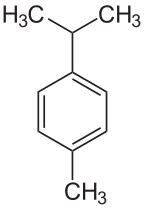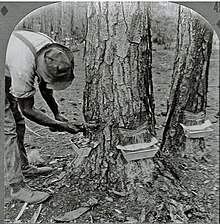Naval stores

Naval stores are all liquid products derived from conifers. These materials include rosin, tall oil, pine oil, and turpentine. Crude gum or oleoresin can be collected from the wounds of living pine trees.
The term naval stores originally applied to the organic compounds used in building and maintaining wooden sailing ships, a category which includes cordage, mask, turpentine, rosin, pitch and tar. These materials were originally used for water- and weather-proofing wooden ships. Masts, spars, and cordage needed protecting, and hulls made of wood required a flexible material, insoluble in water, to seal the spaces between planks. Pine pitch was often mixed with fibers like hemp to caulk spaces which might otherwise leak.
Presently, pine compounds produced by the naval stores industry are used to manufacture soap, paint, varnish, shoe polish, lubricants, linoleum, and roofing materials.[1]
History
[edit]Colonial North America
[edit]
The Royal Navy relied heavily upon naval stores from American colonies, and naval stores were an essential part of the colonial economy. Masts came from the large white pines of New England, while pitch came from the longleaf pine forests of Carolina, which also produced sawn lumber, shake shingles, and staves.[2] In the early 1700s the British Crown was involved in the transplantation of Palatine refuges in Great Britain to the New York Province to produce naval stores.
Naval stores played a role during the American Revolutionary War. As Britain attempted to cripple French and Spanish capacities through blockade, they declared naval stores to be contraband. At the time Russia was Europe's chief producer of naval stores, leading to the seizure of 'neutral' Russian vessels. In 1780 Catherine the Great announced that her navy would be used against anyone interfering with neutral trade, and she gathered together European neutrals in the League of Armed Neutrality. These actions were beneficial for the struggling colonists as the British were forced to act with greater caution.[3]
Zallen tells in detail how turpentine (and rosin) are produced as naval stores.[4] Pine trees especially in North Carolina were tapped for sap which was doubly distilled to make turpentine and rosin (aka resin)–hence the name tar heels. The trees were scored with a ledge called a “box” to collect the sap. Large numbers of slaves were used to score the trees, collect and process the sap. Zallen describes this as industrial slavery–different from the more common vision of slaves in agriculture. By the 1840s camphine, a blend of turpentine and grain alcohol, became the dominant lamp fuel in the US. [Zallen prefers the camphene spelling.]
The pine trees of North Carolina were well suited to camphine production. The business also provided additional need for slaves as production expanded. Backwoods became more productive. Slaves were often leased in winter when agriculture was slower. The value of many was protected by life insurance. Wilmington, NC became a center of the camphene industry. In cities, gaslighting was also available, but used by the upper classes. Camphine was the fuel of the average family.
Zallen reports that after Ft. Sumter, turpentine producers were cut off from major markets. Emancipation left them without manpower to collect and process turpentine. The camps were flammable. Many were burned in William Tecumseh Sherman’s march from Savannah to Goldsboro, NC. Congress also imposed taxes on alcohol to pay for the Civil War. That made camphine more costly than kerosene. Kerosene first produced as coal oil became abundant after the discovery of oil in Pennsylvania.
The major producers of naval stores in the 19th and 20th century were the United States of America, and France, where Napoleon encouraged planting of pines in areas of sand dunes. In the 1920s the United States exported eleven million gallons of spirits. By 1927, France exported about 20 percent of the world's resin.[5]
Separation techniques
[edit]
Today naval stores are recovered from the tall oil byproduct stream of Kraft process pulping of pines in the US, though tapping of living pines remains common in other parts of the world. Turpentine and pine oil may be recovered by steam distillation of oleoresin or by destructive distillation of pine wood. Solvent extraction of shredded stumps and roots has become more common with the availability of inexpensive naphtha. Rosin remains in the still after turpentine and water have boiled off.[6]
See also
[edit]Footnotes
[edit]- ^ Gscheidmeier, Manfred; Fleig, Helmut (2000). Turpentines. doi:10.1002/14356007.a27_267. ISBN 3527306730.
- ^ Greene, Jack P, Pursuits of Happiness, Chapel Hill: University of North Carolina Press, 1988, pp. 144-145
- ^ Crosby, Alfred W., Jr., America, Russia, Hemp, and Napoleon, Ohio State University Press, 1965, pp. 8
- ^ Zallen, Jeremy (2019). American Lucifers: The Dark History of Artificial Light, 1750-1865. Chapel Hill, NC: University of North Carolina Press.
- ^ Outland III, Robert B. (2004). Tapping the pines : the naval stores industry in the American South. Baton Rouge: Louisiana State University Press. ISBN 9780807129814.
- ^ Kent, James A. Riegel's Handbook of Industrial Chemistry (Eighth Edition) Van Nostrand Reinhold Company (1983) ISBN 0-442-20164-8 pp.569-573
External links
[edit]- https://web.archive.org/web/20101009032732/http://www.srs.fs.usda.gov/organization/history/naval_stores.htm
- http://www.maritime.org/conf/conf-kaye-tar.htm
- http://www.fao.org/documents/show_cdr.asp?url_file=/docrep/V6460E/v6460e04.htm
- http://www.hchsonline.org/places/turpentine.html
- https://web.archive.org/web/20070928044420/http://www.unctv.org/exploringNC/episode308.html
